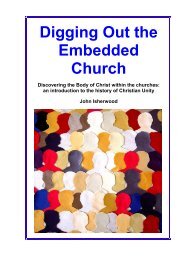Christian Unity (the book) - The Maranatha Community
Christian Unity (the book) - The Maranatha Community
Christian Unity (the book) - The Maranatha Community
You also want an ePaper? Increase the reach of your titles
YUMPU automatically turns print PDFs into web optimized ePapers that Google loves.
<strong>The</strong> Countess’s attempt to bring peace between <strong>the</strong> Wesleys and <strong>the</strong>Inghamites 85 also came to nothing. She sent George Whitefield to Newcastleupon Tyne to try to negotiate with <strong>the</strong>m with a view to <strong>the</strong>ir union, butalthough Charles was amenable to discussion, John Wesley refused to attendeven though Ingham attended Wesley’s Conference. 86Although it was contrary to <strong>the</strong> instinct of her spirit, <strong>the</strong> Countess did getcaught up in <strong>the</strong> latter part of her life in <strong>the</strong> Calvinist/Arminian controversythat divided <strong>the</strong> Evangelical Revival leaders, and, consequently, <strong>the</strong>ircongregations. So keen were <strong>the</strong> feelings on <strong>the</strong> questions of predestinationand free will (and, to make matters worse, on <strong>the</strong> ‘Wesleyan’ doctrine, as itwas perceived to be, of entire sanctification), that when Wesley’s Conferenceof workers in 1770 minuted disapproval of what <strong>the</strong>y considered to be <strong>the</strong>antinomian tendency of Calvinism, Selina found that she could not inviteWesley to <strong>the</strong> second anniversary of <strong>the</strong> founding of Trefeca College. Similardoctrinal differences caused <strong>the</strong> resignation of <strong>the</strong> saintly John W Fletcher,Vicar of Madeley, a close associate of Wesley, as President of <strong>the</strong> college. <strong>The</strong>rift was never healed and, in certain circles, exists to this day.It must be recorded, sadly, that <strong>the</strong> pioneer of <strong>the</strong> Evangelical Awakening inWales, Griffith Jones of Llanddwror, became disaffected with <strong>the</strong> fervour of‘revivalists’ such as Rowland and Harris. As a loyal Anglican, Jones lookedaskance at <strong>the</strong> irregular style of <strong>the</strong>ir preaching in its organisation (itinerantevangelism, crossing parish boundaries willy-nilly), its use of laymen (Harrisnever did become ordained), and its appeal to emotions and experiences. 8785Inghamites. Benjamin Ingham was a member of <strong>the</strong> Holy Club at Oxford University with<strong>the</strong> Wesleys and went with <strong>the</strong>m to Georgia as an ordained Church of England clergyman todo missionary work among <strong>the</strong> settlers of <strong>the</strong> new Colony. Like <strong>the</strong> Wesleys, Ingham wasimpressed by <strong>the</strong> spirituality and faith of <strong>the</strong> Moravians who were on board <strong>the</strong> ship in which<strong>the</strong>y sailed to America. On his return to England Ingham preached widely, concentrating on<strong>the</strong> north of England. Opposition to his preaching by Church authorities led him to preachout of doors and on farms and in cottages and inns in <strong>the</strong> spirit of Whitefield and <strong>the</strong>Wesleys and Howel Harris in Wales. By 1742 50 ‘Inghamite’ Religious Societies had beenfounded and Ingham handed <strong>the</strong>m over to be supervised by <strong>the</strong> Moravian leadership. Hemarried a sister of <strong>the</strong> Countess of Huntingdon, Lady Margaret Hastings.86Stevens, Abel, <strong>The</strong> History of <strong>the</strong> Religious Movement of <strong>the</strong> 18 th Century calledMethodism, ed Willey, William, in 3 Vols, Vol 1, George Watson, London, 1865, pp 318-319.Stevens points out that Wesley’s decision not to attend was based on sound judgement as heprobably sensed <strong>the</strong> inherent instability of what Stevens call Ingham’s ‘mongrel association’.By 1759 this association was beginning to disintegrate.87Evans, Eifion, Daniel Rowland and <strong>the</strong> Great Evangelical Awakening in Wales, <strong>The</strong>Banner of Truth Trust, 1985, p 140.Page 117








